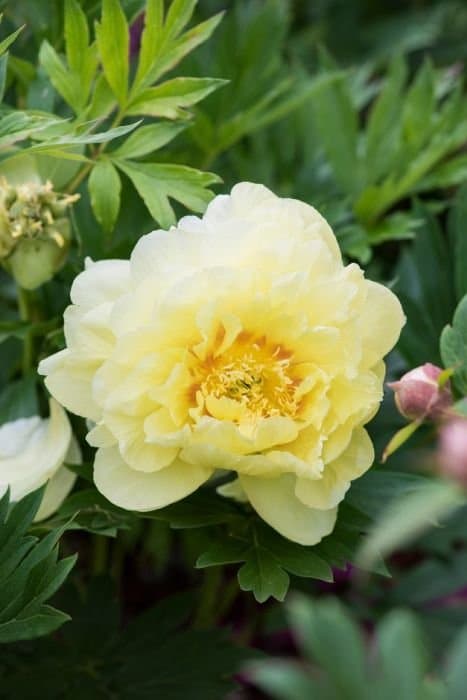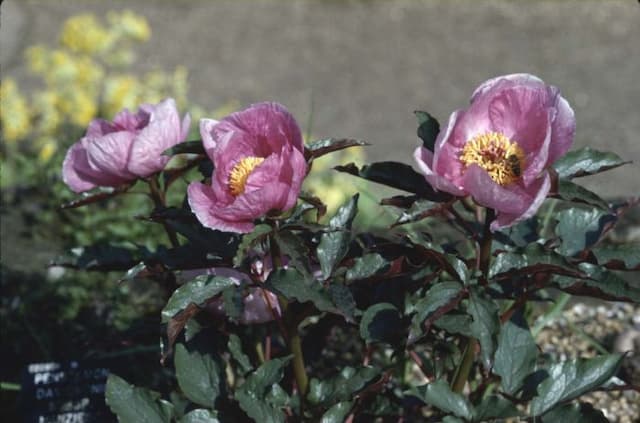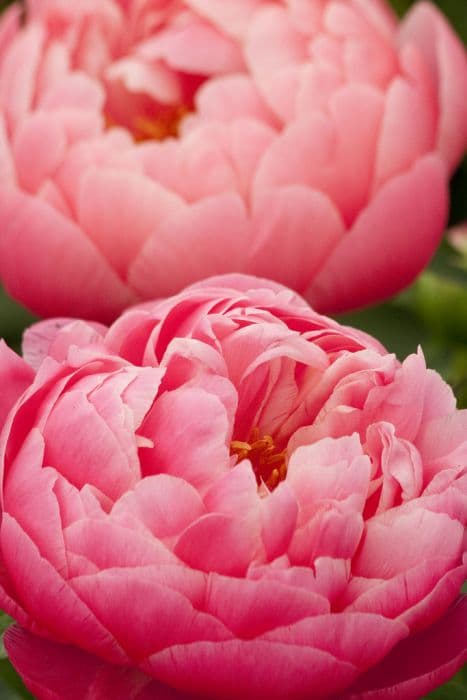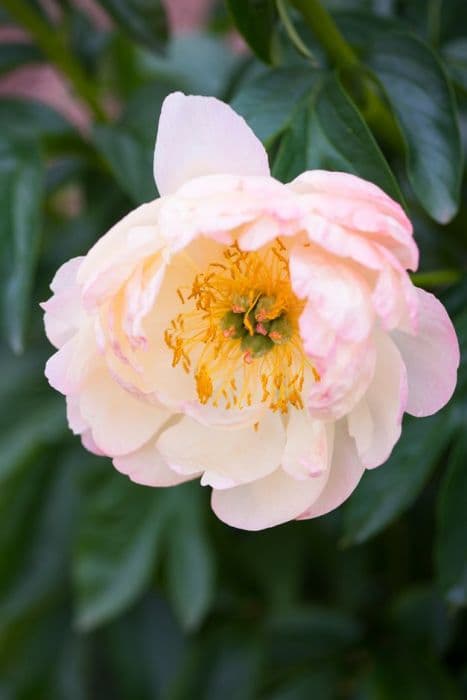Molly the Witch Paeonia daurica subsp. mlokosewitschii

ABOUT
Commonly known as Molly the Witch, this plant is a perennial with a captivating appeal. It features a lush mound of deep green leaves that are intricately divided, providing a delicate, feathery backdrop for its flowers. In spring, it produces large, cup-shaped blooms that are an enchanting soft yellow tone, giving off a gentle, alluring glow in the garden. These flowers have a distinctly elegant and luxurious appearance, with neatly arranged petals that may show subtle variations from plant to plant, sometimes exhibiting a faint pink blush at their bases. Contrasting with the soft yellow petals, the center of the flower is a dramatic collection of golden yellow stamens, which attract a variety of pollinators. Around the base of the stamens, one can often find a set of green carpels, occasionally tipped with darker pink. The visual combination of these elements ensures that Molly the Witch becomes an enchanting focal point during its blooming period. As the season progresses, the plant's flowers give way to seed pods, and the foliage slowly turns into a more subdued shade, often serving as a textured ground cover throughout the growing season. This plant is prized for its striking blooms and is often used to create a point of interest in garden borders, cottage gardens, or even as a specimen in a smaller garden setting. With its alluring yellow tones and contrasting green foliage, Molly the Witch captures the essence of springtime enchantment in the garden.
About this plant
 Names
NamesFamily
Paeoniaceae.
Synonyms
Caucasian Peony, Golden Peony, Mlokosiewicz's Peony.
Common names
Paeonia mlokosewitschii, Paeonia daurica var. mlokosewitschii.
 Toxicity
ToxicityTo humans
The common name for Paeonia daurica subsp. mlokosewitschii is Molly the Witch. There is no specific information suggesting that Molly the Witch is highly toxic to humans. However, peonies in general can cause gastrointestinal upset if ingested in significant amounts. Symptoms may include nausea, vomiting, and diarrhea. Handling peonies can sometimes cause skin irritation due to the presence of compounds like paeonol.
To pets
Molly the Witch is generally considered to be of low toxicity to pets. However, if pets consume parts of the plant, they may experience mild gastrointestinal upset, which can include symptoms such as nausea, vomiting, and diarrhea. It is always advisable to prevent pets from ingesting plants, as individual sensitivity to different substances can vary.
 Characteristics
CharacteristicsLife cycle
Perennials
Foliage type
Deciduous
Color of leaves
Green
Flower color
Yellow
Height
2 feet (0.6 meters)
Spread
2 feet (0.6 meters)
Plant type
Shrub
Hardiness zones
4
Native area
Caucasus
Benefits
 General Benefits
General Benefits- Ornamental value - Paeonia daurica subsp. mlokosewitschii, also known as Molly the Witch, is prized for its beautiful yellow flowers and is often used in gardens and landscapes for aesthetic purposes.
- Pollinator attraction - The plant provides nectar and pollen for various pollinating insects, contributing to biodiversity and helping to sustain the local ecosystem.
- Cultural significance - Molly the Witch peonies have symbolic meanings in different cultures and are used in various ceremonies and traditions.
- Soil improvement - By growing and decaying, peonies can enhance soil quality through organic matter contribution.
- Privacy and borders - Peonies can be used in hedges or as border plants to create privacy and delineate areas in a garden.
- Cut flowers - The blooms of Molly the Witch are highly valued as cut flowers, often used in floral arrangements and bouquets due to their beauty and fragrance.
- Garden design - They can play an essential role in garden design, providing structure, height, and seasonal interest.
- Wildlife habitat - These plants can offer shelter and breeding grounds for various small wildlife, like beneficial insects and birds.
 Medical Properties
Medical PropertiesThis plant is not used for medical purposes.
 Air-purifying Qualities
Air-purifying QualitiesThis plant is not specifically known for air purifying qualities.
 Other Uses
Other Uses- Floral Arrangements: The large, striking blooms of the peony can be used in floral arrangements to provide a burst of color and a touch of elegance to table settings and bouquets.
- Artistic Inspiration: Artists may draw inspiration from the beauty of the peony flowers, leading to paintings, drawings, or even textile patterns that feature its likeness.
- Garden Design: Peonies are commonly used in garden design for their aesthetic appeal and to create focal points or borders in landscape architecture.
- Wedding Decor: Due to their lush and romantic appearance, peonies are a favorite choice for weddings, used in everything from bridal bouquets to reception centerpieces.
- Culinary Garnish: While not recommended for consumption, peony petals can be used as a decorative garnish for sophisticated dishes in high-end culinary presentations.
- Photography Subjects: The vibrant and intricate peony flowers make them popular subjects for photographers, capturing their essence in still life or nature photography.
- Symbolic Gift: Peonies often symbolize prosperity, good fortune, and a happy marriage, making them meaningful gifts for various occasions.
- Cultural Celebrations: In some cultures, peonies play a significant role in festivities and are used as decoration during special events like the Chinese New Year.
- Educational Tool: Botany enthusiasts and educators may use peonies to teach about plant biology, pollination, and the diversity of floral species.
- Perfumery: The scent of some peony species may be used as inspiration or a component in creating fragrances and scented products like candles or potpourri.
Interesting Facts
 Feng Shui
Feng ShuiThe plant Paeonia is not used in Feng Shui practice.
 Zodiac Sign Compitability
Zodiac Sign CompitabilityThe plant Paeonia is not used in astrology practice.
 Plant Symbolism
Plant Symbolism- Prosperity: Paeonia daurica subsp. mlokosewitschii, commonly known as Molly the Witch, is often associated with prosperity due to the lush and abundant appearance of its blooms.
- Honor: The peony family has long been a symbol of honor and high esteem in many cultures, representing the value of one's reputation and integrity.
- Romance and Love: With its full and rounded blossoms, Molly the Witch signifies romance and love, embodying the passionate and sometimes secretive nature of affection.
- Beauty: The attractive colors and shape of the flower symbolize beauty, often capturing the admiration and fascination of those who behold it.
- Compassion: The soft and gentle appearance of the flower can be reflective of compassion and understanding towards others.
- Healing: In some traditions, peonies are considered to have medicinal properties, thus symbolizing healing and the restoration of health.
 Water
WaterMolly the Witch, the most common name of Paeonia daurica subsp. mlokosewitschii, should be watered deeply once every week to ten days during active growth, especially if there hasn't been significant rainfall. This equates to about 1 inch of water, which can be provided by roughly 0.5 gallons for smaller plants or up to 2-3 gallons for larger, established clumps to ensure it reaches the deep roots. During the dormant period in winter, watering should be reduced significantly to prevent root rot. Always check the top few inches of soil for moisture before watering to avoid overwatering.
 Light
LightMolly the Witch prefers a sunny to partly shaded location with at least six hours of sunlight each day. However, in regions with very hot summers, some afternoon shade is beneficial to prevent leaf scorch and to ensure the blossoms retain their vibrant colors.
 Temperature
TemperatureMolly the Witch can survive in temperatures ranging from approximately -20°F to 90°F. The ideal temperature range for this plant is between 60°F and 75°F. It is frost hardy and can withstand cold winters, but it should be protected from extreme heat in the summer.
 Pruning
PruningPrune Molly the Witch after flowering to remove spent blooms, which encourages healthy plant growth and can sometimes stimulate a second, though lesser, bloom period. The best time for pruning is in late summer or early fall. However, avoid cutting back the foliage until it has turned brown in the fall, as the leaves provide energy for next year's growth.
 Cleaning
CleaningAs needed
 Soil
SoilMolly the Witch Peony thrives in fertile, well-draining soil with a pH of 6.0-7.0. A mix of two-thirds garden soil with one-third compost or well-rotted manure is ideal.
 Repotting
RepottingMolly the Witch Peony does not require frequent repotting; it can be repotted every 3-5 years unless the soil breaks down faster.
 Humidity & Misting
Humidity & MistingMolly the Witch Peony prefers moderate ambient humidity and does not require special humidity adjustments.
 Suitable locations
Suitable locationsIndoor
Provide bright indirect light and cool temperatures.
Outdoor
Plant in full sun to partial shade in well-draining soil.
Hardiness zone
4-8 USDA.
 Life cycle
Life cyclePaeonia daurica subsp. mlokosewitschii, commonly known as Caucasian peony, begins its life as a seed, often requiring a cold period to break dormancy. Germination follows, leading to the development of a small root system and a shoot that emerges above the soil. As a perennial, the plant then enters a vegetative stage where it grows leaves to photosynthesize and build energy, with a robust root system that helps it survive yearly cycles. After a few years, the Caucasian peony reaches maturity and its reproductive stage, characterized by the blooming of its distinctive yellow or light pink flowers in spring, which are then pollinated by insects. Following pollination, seeds develop within the carpels, and once mature, they are dispersed by various means, such as by animals or gravity. The plant then goes into dormancy during the cold winter months, with the cycle recommencing the following spring.
 Propogation
PropogationPropogation time
Spring-Early Summer
Propogation: Paeonia daurica subsp. mlokosewitschii, commonly known as Caucasian peony, is typically propagated by division, a popular method used for many herbaceous perennials. Division should be done in autumn, after the plant has gone dormant. To propagate by division, carefully dig up the root ball of a mature plant and gently separate the root clumps into smaller sections, each with at least one ‘eye’ or growth bud. These sections can be replanted in well-draining soil at the same depth they were previously growing. Water them thoroughly after planting to help establish the new divisions. It's important to allow the newly planted divisions to settle without disturbance so they can develop a strong root system before the growing season begins.









